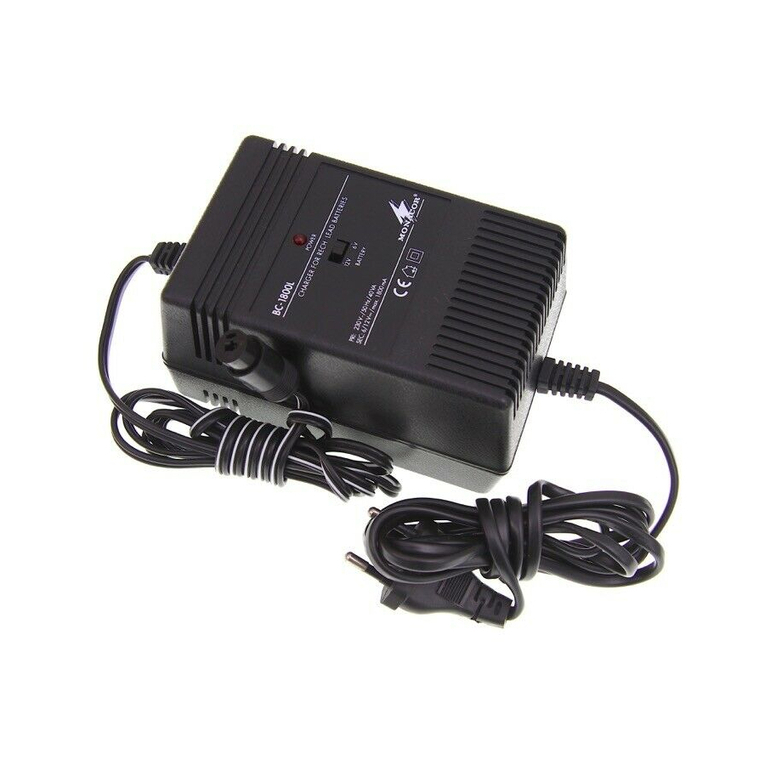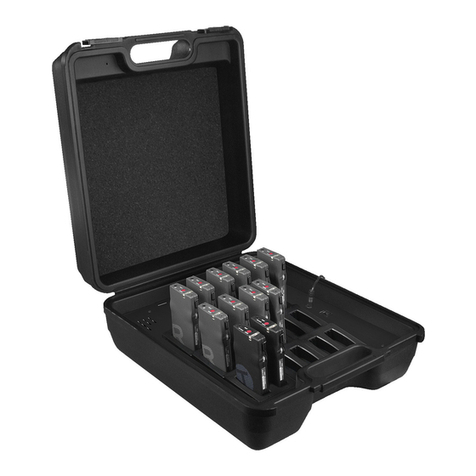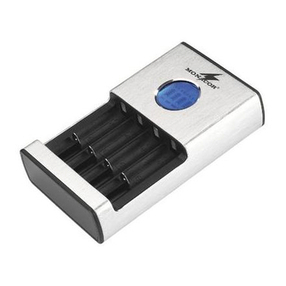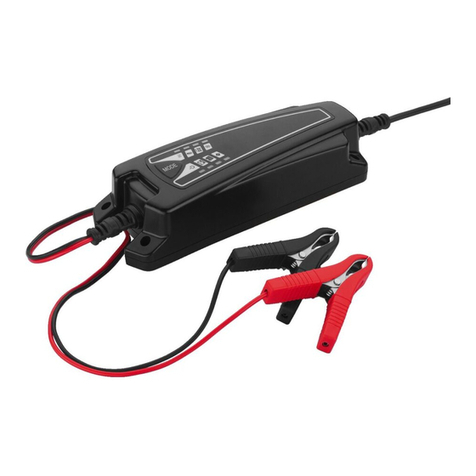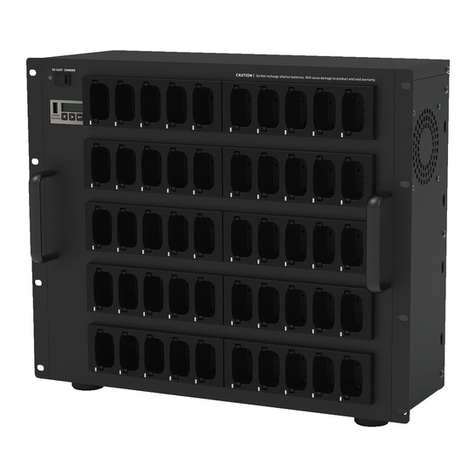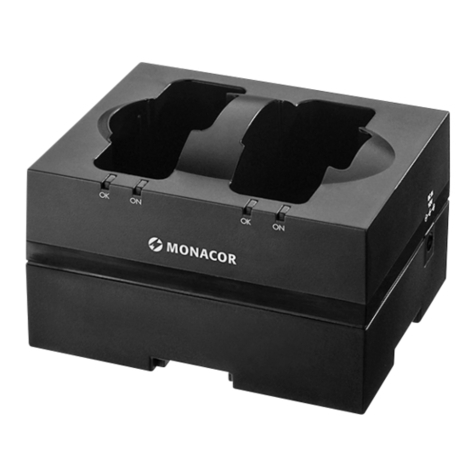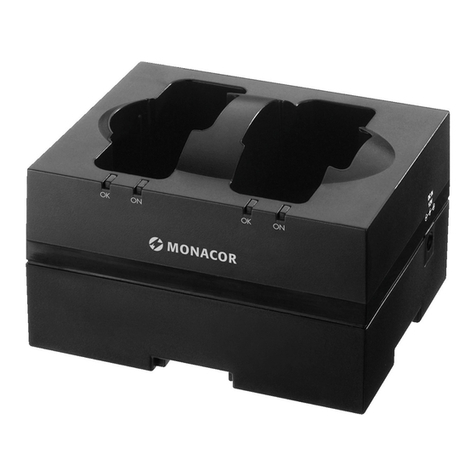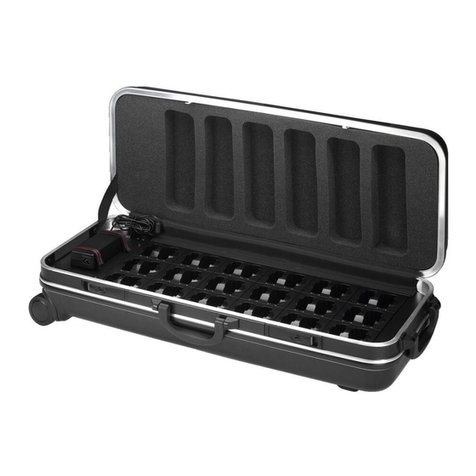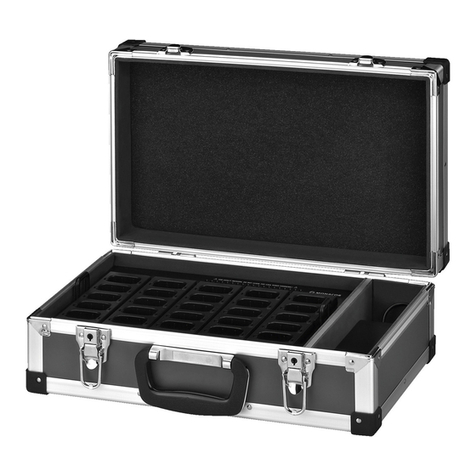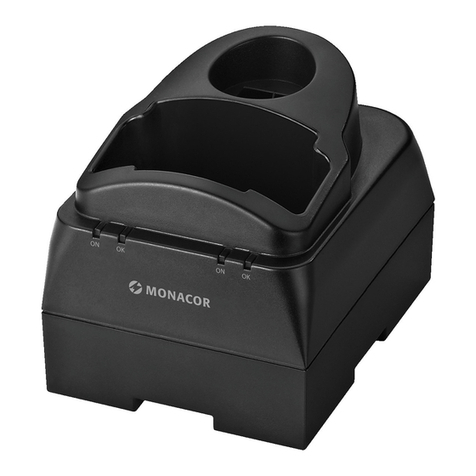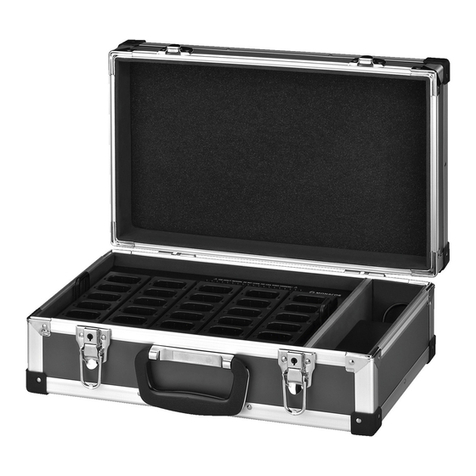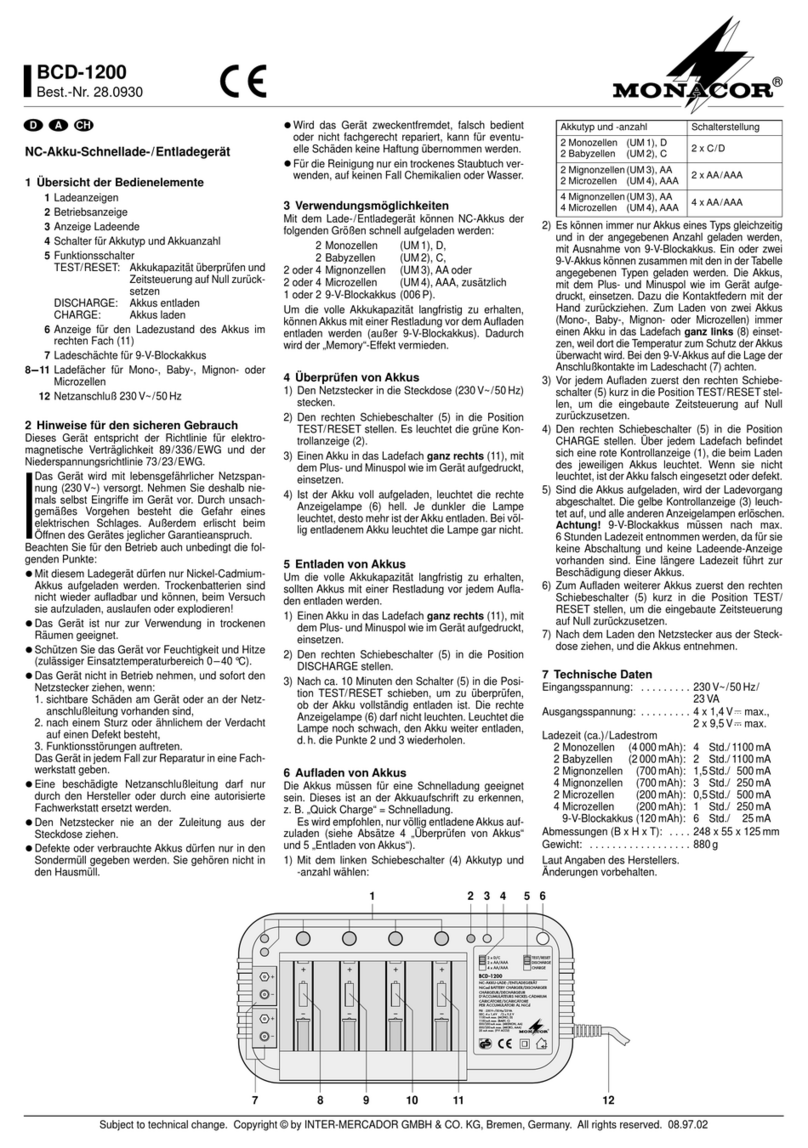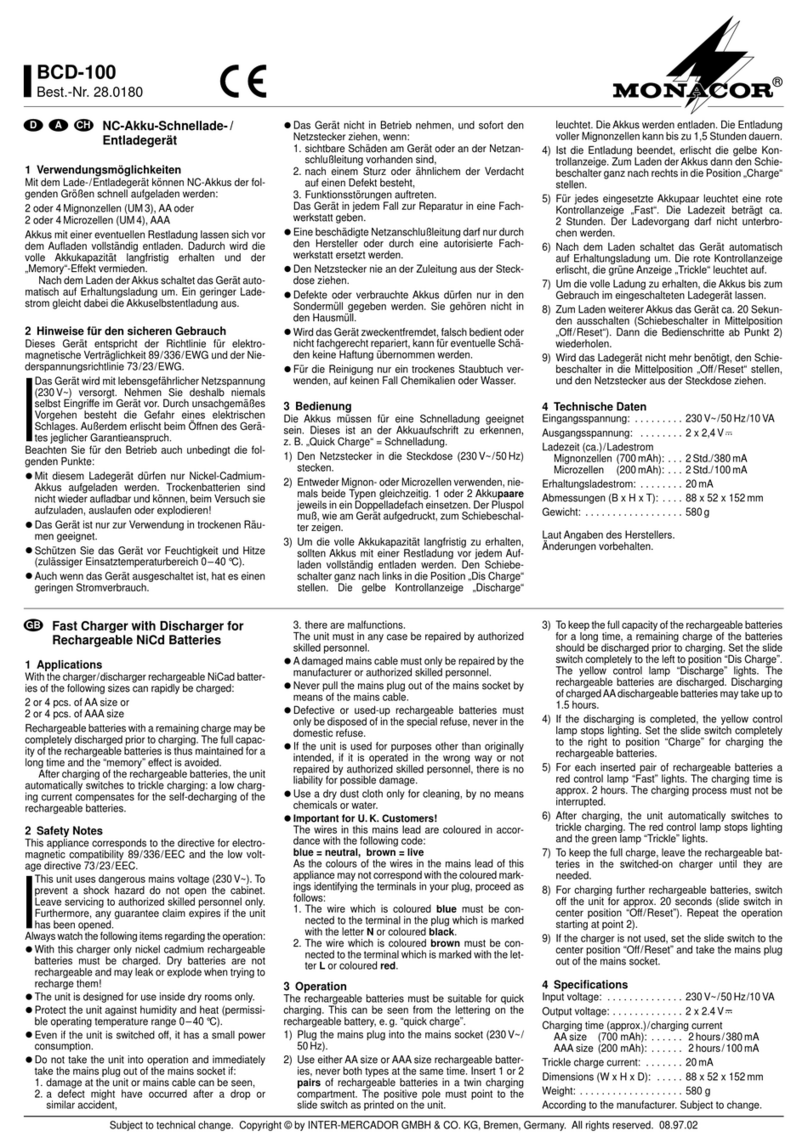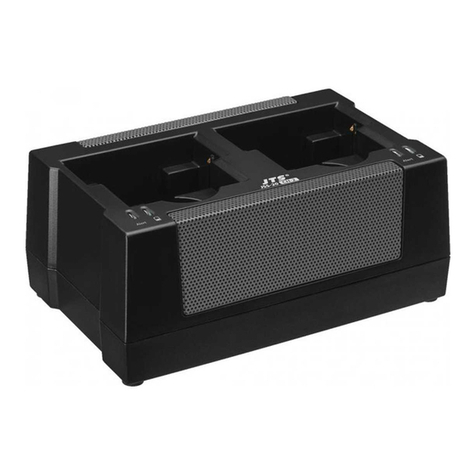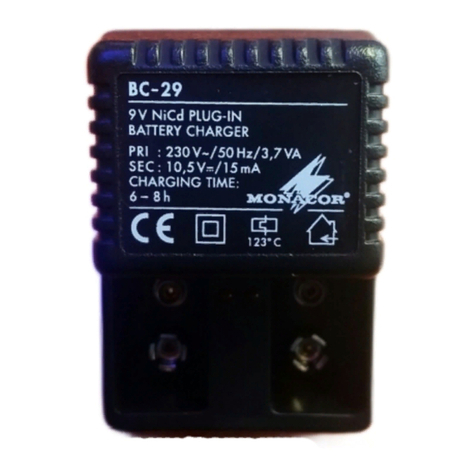ATS-30C
Best.-Nr. 24.4320
wwwwww..iimmggssttaaggeelliinnee..ccoomm
Copyright©by MONACOR INTERNATIONAL GmbH & Co. KG, Bremen, Germany. All rights reserved. A-0315.99.02.03.2005
®
Transportkoffer mit
Ladefunktion
1 Verwendungsmöglichkeiten
In diesem Koffer lassen sich mehrere Taschensen-
derATS-10TM,ATS-10TL und EmpfängerATS-10R
verstauen und komfortabel transportieren:
– im Koffer ATS-12C max. 12 Geräte
– im Koffer ATS-30C max. 30 Geräte
Der Koffer besitzt außerdem eine integrierte Lade-
funktion: BeiAnschluss an das Stromnetz über sein
beiliegendes Netzgerät werden die Akkus aller ein-
gesetzten Geräte gleichzeitig aufgeladen.
2 Hinweise für den sicheren Gebrauch
Der Ladekoffer und das Netzgerät entsprechen der
Richtlinie 89/336/EWG für elektromagnetische
Verträglichkeit. Das Netzgerät entspricht zusätzlich
der Niederspannungsrichtlinie 73/23/EWG.
BeachtenSie auch unbedingt die folgendenPunkte:
●Mit diesem Ladekoffer dürfen nur NiCd-Akkus
oder NiMH-Akkus aufgeladen werden. Nicht wie-
deraufladbareBatterien könnenbeim Versuchsie
aufzuladen, auslaufen oder explodieren!
●Setzen Sie zum Aufladen nur Akkus gleichen
Typs in den Sender oder Empfänger und tau-
schen Sie die Akkus immer paarweise aus.
Achtung! Das Netzgerät wird mit lebensgefähr-
licher Netzspannung versorgt. Nehmen Sie des-
halb nie selbst Eingriffe am Gerät vor. Durch un-
sachgemäßes Vorgehen besteht die Gefahr eines
elektrischen Schlages. Außerdem erlischt beim
Öffnen des Geräts jeglicher Garantieanspruch.
●Der Ladekoffer und das Netzgerät sind nur zur
Verwendung im Innenbereich geeignet. Schützen
Sie die Geräte vor Tropf- und Spritzwasser, hoher
Luftfeuchtigkeit und Hitze (zulässiger Einsatz-
temperaturbereich 0–40°C).
●StellenSie keine mitFlüssigkeit gefülltenGefäße,
z.B. Trinkgläser, auf die Geräte.
●Nehmen Sie den Ladekoffer nicht in Betrieb bzw.
ziehen Sie sofort den Netzstecker des Netzgeräts
aus der Steckdose:
1. wenn sichtbare Schäden am Ladekoffer, am
Netzgerät oder an der Netzanschlussleitung
vorhanden sind,
2. wenn nach einem Sturz oder Ähnlichem der
Verdacht auf einen Defekt besteht,
3. wenn Funktionsstörungen auftreten.
LassenSie dieGeräte in jedemFall ineiner Fach-
werkstatt reparieren.
●Ziehen Sie den Netzstecker des Netzgeräts nie
am Kabel aus der Steckdose, fassen Sie immer
am Stecker an.
●Verwenden Sie für die Reinigung nur ein trocke-
nes, weiches Tuch, niemals Wasser oder Chemi-
kalien.
●Werdendie Geräte zweckentfremdet, nicht richtig
angeschlossen oder nicht fachgerecht repariert,
kann keine Haftung für daraus resultierende
Sach- oder Personenschäden und keine Garan-
tie für die Geräte übernommen werden.
Sollen die Geräte endgültig aus dem Betrieb ge-
nommen werden, übergeben Sie sie zur umwelt-
gerechten Entsorgung einem örtlichen Recycling-
betrieb.
3 Aufladen der Akkus
1) Den Koffer öffnen. Die Buchse für denAnschluss
des Netzgeräts befindet sich neben dem ganz lin-
ken hinteren Ladeschacht. Den Kleinspannungs-
stecker des Netzgeräts in die Buchse stecken.
2) Das Netzgerät über das mitgelieferte Netzkabel
an eine Steckdose (100–240V~/50–60Hz) an-
schließen.BeiAnschluss andasStromnetzleuch-
tet die Betriebsanzeige am Netzgerät und die
LEDs der Ladeschächte leuchten kurz grün auf.
(Wird der Koffer von der Stromversorgung ge-
trennt, sollten vor einer erneuten Inbetriebnahme
15sverstreichen, anderenfallskönnten dieLade-
anzeigen nicht richtig funktionieren.)
3) Die aufzuladenden Akkus in den Sender/Emp-
fänger einsetzen.
4) Den Sender/Empfänger so herum in einen Lade-
schacht setzen, dass sich seine Gürtelklemme in
der Aussparung neben dem Schacht befindet.
5) Während des Ladevorgangs leuchtet die LED für
den jeweiligen Ladeschacht rot.
6) Sind dieAkkus voll aufgeladen, leuchtet die LED
des Ladeschachts grün. Den Sender/Empfänger
dann aus dem Ladeschacht nehmen.
7) Wird der Koffer nicht zum Aufladen benutzt, das
Netzgerät vom Stromnetz trennen, um nicht un-
nötig Strom zu verbrauchen.
4 Technische Daten
Einsatztemperatur: . 0 – 40 °C
Stromversorgung: . . 12 V /5 A über beilieg. Netzgerät an
100 – 240 V~/ 50 – 60 Hz/50 VA
Abmessungen: . . . . ATS-12C 300 x 170 x 280 mm
ATS-30C 660 x 170 x 300 mm
Änderungen vorbehalten
Transport Case with Charging
Facility
1 Applications
This case allows storage and convenient transport
of several ATS-10TM, ATS-10TL pocket transmit-
ters and ATS-10R receivers:
– case ATS-12C: 12 units max.
– case ATS-30C: 30 units max.
In addition, the case is equipped with an integrated
charging facility: When connected to the mains via
itssuppliedpower supplyunit,the rechargeablebat-
teries of all units inserted will be charged at the
same time.
2 Safety Notes
The charging case and the power supply unit corre-
spond to the directive for electromagnetic compati-
bility 89/336/EEC. The power supply unit also cor-
responds to the low voltage directive 73/23/EEC.
Please observe the following items in any case:
●Onlyuse this case for chargingNiCd or NiMHbat-
teries. If non-rechargeable batteries are charged,
this may result in leakage or explosion!
●Only insert rechargeable batteries of the same
type into the transmitter or the receiver and
always replace the batteries in pairs.
●The charging case and the power supply unit are
suitable for indoor use only. Protect the units
against dripping water and splash water, high air
humidity, and heat (admissible ambient tempera-
ture range 0–40°C).
●Do not place any vessel filled with liquid on the
units, e.g. a drinking glass.
Attention! The power supply unit is supplied with
hazardous mains voltage. Leave servicing to skilled
personnel only. Inexpert handling may cause an
electric shock hazard. Furthermore, any guarantee
claim will expire if the unit has been opened.
●Do not operate the charging case or immediately
disconnect the mains plug of the power supply
unit from the socket
1. in case of visible damage to the charging case,
to the power supply unit, or to the mains cable,
2. if a defect might have occurred after the unit
was dropped or suffered a similar accident,
3. if malfunctions occur.
In any case the units must be repaired by skilled
personnel.
●Never pull the mains cable for disconnecting the
mains plug of the power supply unit from the
socket, always seize the plug.
●For cleaning only use a dry, soft cloth; never use
chemicals or water.
●Noguarantee claims for the unitsand noliability for
anyresultingpersonaldamage ormaterialdamage
will be accepted if the units are used for other pur-
poses than originally intended, if they are not cor-
rectly connected or not repaired in an expert way.
●Important for U.K. Customers!
Thewiresinthe mainsleadofthe powersupplyunit
are coloured in accordance with the following code:
green/yellow = earth,
blue = neutral, brown = live
Asthecolours ofthewires in themains lead ofthis
appliance may not correspond with the coloured
markings identifying the terminals in your plug,
proceed as follows:
1. The wire which is coloured green and yellow
must be connected to the terminal in the plug
whichis markedwith theletter Eorby theearth
symbol , or coloured green or green and
yellow.
2. The wire which is coloured blue must be con-
nected to the terminal which is marked with the
letter Nor coloured black.
3. The wire which is coloured brown must be con-
nected to the terminal which is marked with the
letter Lor coloured red.
Warning – This appliance must be earthed.
3 Charging the Batteries
1) Openthecase.The jack forconnecting the power
supply unit can be found next to the rear charging
compartment on the left. Connect the low-voltage
plug of the power supply unit to the jack.
2) Connect the power supply unit via the supplied
mainscable to a socket (100–240V~/50–60Hz).
When connected to the mains, the power LED on
the power supply unit lights up and the LEDs of the
charging compartments shortly show green. (After
disconnectingthecasefrom thepowersupply, wait
for15sbefore setting it into operationagain, other-
wisethechargingLEDsmaynotoperatecorrectly.)
3) Insert the batteries to be charged into the trans-
mitter/receiver.
4) Insert the transmitter/receiver into a charging
compartment in such a way that its belt clip fits
into the recess next to the compartment.
5) During the charging process, the LED for the cor-
responding charging compartment shows red.
6) If the batteries are fully charged, the LED of the
chargingcompartment showsgreen. Inthis case,
remove the transmitter/receiver from the charg-
ing compartment.
7) If the case is not used for charging, disconnect
the power supply unit from the mains to prevent
unnecessary power consumption.
4 Specifications
Ambient temperature: 0 – 40 °C
Power supply: . . . . . 12 V /5 A via supplied power supply
unit connected to
100 – 240 V~/50 – 60 Hz /50 VA
Dimensions: . . . . . . ATS-12C 300 x 170 x 280 mm
ATS-30C 660 x 170 x 300 mm
Subject to technical modification.
If the units are to be put out of operation defini-
tively, take them to a local recycling plant for a dis-
posal which is not harmful to the environment.
ATS-12C
Best.-Nr. 24.3930
GB
D A CH
